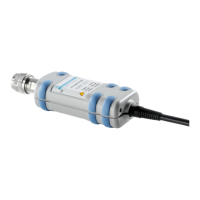R&S NRP-Z11/21/31/41/61/211/221 Remote Control - Commands
1137.7470.12 6.13 E-7
more than 9 periods. With smoothing deactivated, the situation is considerably more unfavorable. In this
c
ase, 300 instead of 5 periods are required, and the fluctuations do not disappear completely until there
are 3000 or more periods.
The query yields the currently set width of the sampling window in seconds.
Default setting: 0.02 [s]
SENSe:POWer:AVG:BUFFer:SIZE[?] 1 to 1024
SENSe:POWer:AVG:BUFFer:SIZE sets the buffer size for the buffered Continuous Average mode.
The query yields the current buffer size for the buffered Continuous Average mode.
Default setting: 1
SENSe:POWer:AVG:BUFFer:STATe[?] OFF | ON
The buffered Continuous Average mode is activated with ON and deactivated with OFF. In this mode,
the results generated by trigger events are collected in the sensor until the buffer is filled. All results are
then transferred as block data. The measurement rate obtained is thus higher than in the non-buffered
Continuous Average mode. The maximum measurement rate is obtained by combining the buffered
mode with multiple triggering (see parameter TRIGger:COUNt). The size of the result buffer is set with
the SENSe:POWer:AVG:BUFFer:SIZE command.
The query yields
• 1 for OFF,
• 2 for ON.
Default setting: OFF
SENSe:POWer:AVG:SMOothing:STATe[?] OFF | ON
The ON parameter activates a smoothing filter for modulated signals in the Continuous Average mode
and OFF deactivates it. The smoothing filter is a steep-edge digital lowpass filter used to suppress
variations of results caused by low-frequency modulation. This parameter should be activated to reduce
variations in results due to modulation when the size of the sampling window cannot or should not be
exactly adapted to the modulation period. If the selected sampling window is 5 to 9 times larger than a
modulation period, the variations in display are normally sufficiently reduced. With smoothing
deactivated, 300 to 3000 periods are required to obtain the same effect.
With smoothing deactivated, the sampling values are considered equivalent and averaged in a
sampling window, which yields an integrating behaviour of the measuring instrument. As described
above, optimum suppression of variations in the result is thus obtained when the size of the sampling
window is exactly adapted to the modulation period. Otherwise, the modulation can have a
considerable influence, even if the sampling window is much larger than the modulation period. The
behaviour can be considerably improved by subjecting sampling values to weighting (raised-von-Hann
window), which corresponds to video filtering. This is exactly what happens with activated smoothing.
Since the smoothing filter increases the inherent noise of the sensor by approx. 20%, it should remain
deactivated if it is not required.
The query yields
• 1 for OFF,
• 2 for ON.
Default setting: OFF

